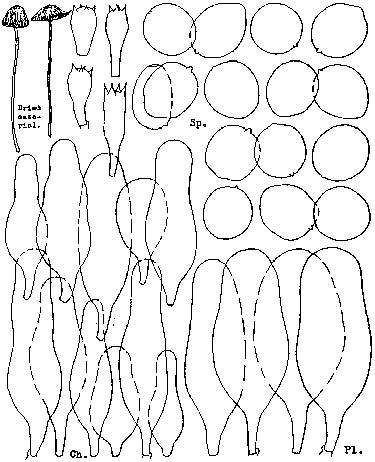Macroscopic features |
Pileus 4-15 x 3-10 mm when still closed, 10-30 mm wide when expanded, first ellipsoid or ovoid, then campanulate to convex, finally flattened, sulcate-striate up to centre, rather dark grey-brown, sordid rust, becoming paler on maturity. Lamellae, L = 20-30, l = 0-3, free, somewhat remote from stipe, whitish, then grey-brown to blackish. Stipe up to 70 x 1-3 mm, with slightly bulbous base, whitish to pale, sordid yellowish-brownish. |
Microscopic features |
Spores 8.0-11.0 x 7.3-9.7 x c. 7.0-7.5 µm, Q = 1.00-1.30, av. Q = 1.05-1.15, av. L = 9.3-9.5, av. B = 8.4 µm, (sub)globose, some ones tending to limoniform and slightly 5-angular, lentiform, with slightly eccentric germ pore and rounded base and apex, dark red-brown. Basidia 20-40 x 8-12 µm, 4-spored, surrounded by 4-6 pseudoparaphyses. Pleurocystidia 60-95 x 18-30 µm, upper part 16-23 µm wide, lageniform to weakly utriform. Cheilocystidia 25-60 x 10-23 µm, most lageniform with 6-15(-18) µm wide upper part. Pileipellis smooth, hymeniform, made up of spheropedunculate cells. Clamp-connections present. |
Habitat & distribution |
Terrestrial on bare, often clayey soil, also at grassy places. Solitary or a few together. Very rare in the Netherlands. Recorded and from England. |
Remarks |
The (sub)globose spores and perhaps the darker colour distinguish C. galericuliformis from the very close related C. leiocephus. |

[Copyright © by ]